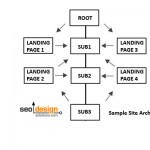If queried on what the three primary and fundamental SEO ranking factors are for enhancing a website in the SERPs, the response, based on order of importance my reply is (1) a body of themed and relevant content (b) keyword-rich internal links and deep links from other sites (3) and in-depth keyword research mirrored within the URL or site architecture.

3 Primary SEO Metrics
There are various metrics which contribute, such as relevant titles, canonicalization, server settings, site age, exposure, citation and others, but we are referring to the more immediate elements under your control that you can contribute to daily that can make a difference.
Content Relevance:
Content relevance thresholds are the first phase in overcoming the barrier to entry. Sites that occupy top ranking positions have earned the authority based on the sites local and global co-occurrence of keywords and related content.
This content should be based on competitive market analysis and nodes of relevance that are present in the market. Coupled with keyword modifiers, you can take base level phrases and align them with alternative “search savvy” phrases to increase traffic and engagement levels.
These alternative variations are often less competitive than the more searched root phrases, but can yield significant traffic in a fraction of the time and then “stem” into other related mid-tail and long-tail keyword variations.
For a definition of root phrase think of the keyword “lawyer” for mid-tail “personal injury lawyer” for a long-tail variation a phrase like “affordable personal injury lawyer in ______” and adding a city or state would suffice.
Each of the keyword variations has a threshold of how many pages are competing for the top 10 positions in the search engine’s index. More competitive keywords require more time, content, links and coherent site architecture to dial-in a top ranking. Also, the more links and / or content you have the easier it is to sculpt rankings based on keywords that represent the most value for your business.
It is this content that anchors the body of content or preferred landing pages in the SERPs, based on the coherence and continuity that is reflected in trends, synonyms and / or themed keywords from within a market or niche.
Each page functions like a piece in a puzzle and contributes to a websites on page relevance score and authority within a niche, segment or market. If no clear champion exists, then it is easy to occupy multiple nodes of relevance (much like Wikipedia) by using the citation of peer review (others linking to a site) as well as reinforcing topical relevance at every opportunity from using keyword-rich internal links.
Having a higher relevance score allows you to (1) use PPC to augment traffic and (2) rank organically through unifying the content (using internal links) to provide supportive rankings to other themed pages while ranking for specific / designated keywords for each page.
Although we prefer to keep things organic for higher ROI, each has its place (organic positioning or paid advertising) in the grand scheme of online marketing.
Keyword Rich Anchor Text:
On page optimization and content relevance need to be combined with internal linking. These keyword-rich anchors should be based on solid keyword research and also built into the site architecture via the main site navigation, the url / naming conventions and as inbound links from other sites.
Based on how pages are internally linked designates which pages are returned in the SERPs for specific keyword queries. Links from other sites (deep links if they link to pages other than the homepage) are responsible for adding significant weight to the page through a metric known as peer review.
The more sites that link to a page or a website with a cluster of keywords represented by the on page content equivalents score a higher degree of relevance than websites who ignore these metrics and (a) do not use relevant internal links or (b) gain inbound links from outside sources to the website to increase relevance score.
Despite the various discrepancies in a unified body of SEO logic (based on collective and / or personal experience), we can only speak from our own experience. In this capacity, we have found that once a site acquires a degree of authority via page rank, backlinks or age, the internal links can pass along that ranking factor just as external links from other sites are used to rank web pages.
In this vein, there is very little difference between how internal and or external links are calculated from the standpoint of search engines. Both contribute to a websites inherent ranking factors and should be encouraged to support the pages ideal keyword variations the page is intended to rank for.
Keyword Research and Site Architecture:
While these are not the last, but rather the first metrics a site owner should address and the content and internal links are supplemental to it, it is the last on our list to discuss. This is the starting point – “the alpha” point for market domination and where many ranking battles are fought and won from the perspective of the more subtle aspects of SEO.
The trends in the market, both seasonal and otherwise can be found through competitive research analysis and vertical market analysis. Based on that analysis, upper management can determine which keywords and / or phrases yield the most lucrative traffic for your offering.
The premise of SEO is to take this actionable intelligence and then integrate it into a solid game plan which mirrors the on page and off page needs through a thread of continuity. The more this continuity is reinforced naturally from various metrics from both within the site and from outside the site, the more referential integrity spawns as a result.
This integrity translates as relevance and authority (which is the real purpose of optimization). SEO is not designed to compete with others, but rather streamline the continuity and coherence of your own content to (a) elicit the regard of others within the space and (b) provide structure for search engines to access, interpret and score than content so they it may refer other users to it as a result of the signals amplified through the unification of best practices that are conducive to the search engines design.
Search engines are social barometers designed to serve useful and authoritative content to those in need or searching for that content based on the keyword variations they use in query space, i.e. the search box.
This means that the more relevant the nodes of relevance are (using titles, url naming conventions, meta titles and descriptions, internal links and inbound links from other sites), the higher a page and / or pages within a site can rank for the keywords they were intended to.
By removing inconsistencies through manual revisions or using a CMS to automate best practices (such as tagging, internal linking based on keyword occurrence, etc.), you can let the template and content management system work on your behalf while your content team focuses on creating relevant content extracted from high level keyword intelligence.
This convergence of relevant content, traffic, user engagement and relevance are the crowning achievement of a well orchestrated SEO campaign which uses all of the moving parts to convey a unified purpose.










Why the sudden stop of adding anchor-text in the last couple of blog post?
Did I miss something?
I had a glitch yesterday, I took over 45 minutes to find the articles in the links and link them, then when I posted the article was gone, so I had to start over.
I am replacing the links to pertinent areas now…Good catch Slim Jim!
Very very informative post.You are just writing on your blog what I actually want to learn. I am also blogging on SEO, link building and I have been sharing the different method of link building strategy on my blog.
Chandan:
Thanks for all of the recent comments, although I have not been able to formally respond.
I will definitely check out your blog and appreciate all of your feedback.
Looking forward to your insightful comments in the future.
All the best…
Excellent post. I think the 3 SEO Principles are the most important to start with.